|
Page no. |
Image no. |
Description |
Thumbnail |
| Cover |
wild_
0001 |
Wild Life
Conservation in the Southern Appalachians |
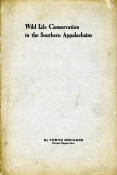 |
| 1 |
0002 |
WILD LIFE CONSERVATION IN THE
SOUTHERN APPALACHIANS By Verne Rhoades, Forest Supervisor Pisgah
National Forest and Game Preserve
It is the purpose of this paper to briefly discuss the conditions
surrounding wild life in this country during the colonial period and
through the life of the Republic; to set forth the facts of its present
day existence; to bring the question of game preservation nearer home by
contrasting the records and the experiences of certain other states with
those of North Carolina; and finally to suggest a constructive program
for furthering the conservation of fish and game, which should be
followed by both the Federal and State Governments in the Southern
Appalachians, a region arbitrarily defined for the purpose of this
sketch as the mountain section south of Pennsylvania.
The opinions of men undergo great changes as time passes and as
experiences multiply or repeat themselves. "Fifty years ago," says Dr.
Hornaday, "the preservation of wild life was a sentimental cause, of
practical interest only to sportsmen. Today it is not only acutely
sentimental, but it has become also intensely practical to the public at
large." Formerly arguments based on commercial or economic
considerations were ineffective because the great body of the population
believed that the source of supply would be forever bountiful. Now, with
wider knowledge gained from observation, by word of mouth of men who
travel much afield, and thru the publications of hunters and
naturalists, we have learned definitely that instead of filling from
inexhaustible springs, the wells of supply have too often had their
levels lowered to such great depths that the recovery of certain species
of animal life is not longer possible through any effort of man.
|
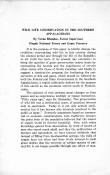 |
| 2 |
0003 |
A number of species of both birds and
mammals have vanished, while at the present time other species are fast
approaching extinction. Like the animals of prehistoric days a few of
their skeletons will drape the walls of fine museums—those tombs which
too frequently show the passerby how often has our civilization erred by
establishing show cases for the bones of the dead instead of providing
refuges for the living, while there was yet time. But let us look
together for a moment upon the picture of wild life on this continent
200 years ago, and as it continued to be for a long period thereafter.
The early colonists found the land abundantly stocked with game. The
lakes within and the coastal waters without the land were covered with
waterfowl. An unbroken forest extending from shore-line to the prairie's
eastern edge was filled to overflowing with deer, elk, moose, bear,
bison, wild turkey, grouse, and vast quantities of smaller game. During
the period of migration early writers record that the waters where swans
resorted appeared as if dressed in white drapery. Mighty flocks of geese
and wild ducks innumerable wintered in Virginia and the Carolinas. The
wild turkey was described as the most important fowl of the country and
was found in large flocks in every woodland. They were often bought for
20 cents each in the New Netherlands. It is recorded that the heath hen,
or eastern prairie chicken, was so plentiful in New England that oftimes
in the articles of apprenticeship it was specified that the apprentice
should not be compelled to eat the meat of it more frequently than twice
each week. We read that the Indians in bands of two and three hundred
visited the nesting places of wild pigeons and there feasted on squabs
for weeks at a time.
As to the larger game a similar story of its numerical strength is
told. Moose were everywhere abundant throughout their natural range. Elk
were so numerous in spring time that often a hundred could be tallied on
a square mile. And it strikes the most imaginative of us as almost
incredible, to learn on excellent authority that
|
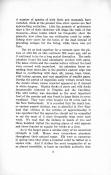 |
| 3 |
0004 |
as many as 10,000 buffalo frequently
visited certain salt springs in central New York. It is small wonder
that Indians believed that game issued from great caverns in the earth
and that the supply could not diminish. There was reason for the white
settlers to think that extinction could only be local; that it could
never become general. Settlement in the country was slowly
accomplished from the coastal plain to the western base of the
Appalachian Range. It was a century and a half creeping from coast line
to mountain crest. The line of permanently advancing settlement was not
in Eastern Kentucky for example, until 1760, or thereabout. It was still
another hundred years chopping its way to the eastern edge of the Great
Plains. So slowly had population increased as compared with the
destruction of game that only a few laws pertaining to wild life were
placed on the statute books of any state prior to the beginning of the
19th century. Special laws protecting insectivorous birds began to be
enacted in the 'fifties and 'sixties, but it was not until after the
Civil War that the movement for adequate protection had its real
inception.
Game still continued to be abundant in some regions. As illustrative
of the conditions during the middle of the last century, the report made
by a select committee of the Senate of Ohio, in 1857, is most
illuminating. This report was made in connection with a bill proposed to
protect the passenger pigeon. "The passenger pigeon needs no protection.
Wonderfully prolific, having vast forests to the North as its breeding
grounds, traveling hundreds of miles in search of food, it is here today
and elsewhere tomorrow and no ordinary destruction can lessen its
numbers, or be missed from the myriads that are yearly produced." Yet
what was the story to tell a half century later? The last passenger
pigeon known on the continent died in the Zoological Gardens of the city
of Cincinnati. The market gunners had done their job only too well.
Game, of course, was always actually decreasing despite the fact of
its seeming continued abundance. Buf-
|
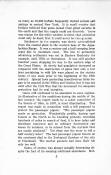 |
| 4 |
0005 |
falo east of the Alleghanies were exterminated by 1730. Elk stayed in
portions of their former range, notably Pennsylvania, as late as 1850.
Both bison and elk were extinct in North Carolina by the time of the
Revolution. The principal cause of the decrease in earlier days is
attributable directly to the heavy and unnecessary and utterly reckless
killing by hunters. Deer were shot in great numbers and only the
haunches were used. Wild geese were shot as food for dogs. Great
canebrakes were set on fire in order to drive out game for furnishing
the day's sport, and, in the burning, the haunts and nesting places and
bedding grounds of animals and birds were destroyed. Buffalo even in the
earliest times were often killed only for the sake of a tidbit such as
the tongue, the balance being left to birds and beasts of prey.
In more recent times in accounting for the diminishing numbers of
game, we find a still more potent agency of destruction, namely the
unregulated trade in the flesh and skins of slaughtered wild life. This
sort of destruction grew by leaps and bounds, as the cities grew in
population, as firearms were perfected and cheapened, and as the haunts
of game were more easily reached by railroad. Dr. Hornaday in his book,
"Our Vanishing Wild Life," states that "beyond reasonable doubt the
traffic in dead game is responsible for at least three-fourths of the
slaughter that has so reduced our game birds to the present remnant of
their former abundance. There is no influence so deadly to wild life as
that of the market gunner."
A third factor which contributed and still does contribute to the
reduction of game, and which has the merit of being a well founded
reason, is the change of forestland to cultivated and pasture land.
Forests, the natural cover of most game, were cut away and the fields of
grain and meadow took their place. With its permanent shelters
destroyed, wild life had to succumb in part, though no one will deny
that the numbers have been reduced to a point far in excess of actual
necessity. It is axiomatic that, as the country is more fully occupied
by man, it must be
|
 |
| 5 |
0006 |
less and less occupied by game. But for all the truth in this statement
it is still both practicable and desirable to preserve an appreciable
quantity of wild life. The true objective sought is the complete
development of all the ways in which our wild life forms may be enjoyed
between the extremes of observing them solely for the pleasure derived
from their appearance and actions in their free state, and the
exhilaration of the chase and the taking and utilization of the food.
All of us are poignantly aware of the fact that today there is but a
remnant of wild life in the whole Southern Appalachians. Even the common
white tailed deer, hardy and fecund as it is, exists only in private
game preserves, or in scattered groups here and there. It is doubtful if
there are today more than 25 head of deer in the mountains of East
Tennessee and Western North Carolina outside of the Toxaway property,
the head of Tuckaseegee and Pisgah Forest. Horace Kephart in his volume,
"Our Southern Highlanders," says, "that a stranger in these mountains
will be surprised at the scarcity of game. It is not unusual for one to
hunt all day long in an absolute wilderness where no track of fowl or
animal is seen. There is really very little game in them in comparison
with sections of the Adirondacks, Maine, and Canada, where game has been
conserved for many years. It used to be the same up there." "In 1877 a
certain naturalist writing of the Maine woods said, 'the most striking
feature of the forest after one has become habituated to the gloom, the
pathlessness, and the impenetrability of the screen it forms around him,
is the absence of animal life. One may wander for hours without seeing a
living creature. One thinks of woods and wild beasts, yet in all my
years of wilderness wandering I can catalog all of the wild animals I
have seen other than squirrels and grouse and small birds. Here is the
list: One deer, one porcupine, one marten, and half a dozen hares." And
yet the Southern Appalachians offer one of the most favorable game
harborages to be found on the face of the entire globe. It is the
highest, roughest, best watered, most densely
|
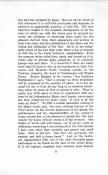 |
| 6 |
0007 |
forested, most lavishly endowed with
varied forms of plant life, and at the same time is the most thinly
populated section east of the Mississippi. Less than one-iourth of it is
under cultivation and in pasture. In many parts of it, indeed, there is
less cleared land today than was the case 50 years ago. That remark has
but recently been applied to Buncombe County. The Southern Appalachians
will make ideal game refuges. They are ready, whenever the public will
demands, for restocking with those species of wild life which are
suitable to present day conditions; they are ready for systematic and
controlled development of the wild life resources. Is it desirable to
have wild life back in some of its former haunts? The answer is
affirmative, if only for sentimental reasons. But it is desirable also
because of the tangible assets which accrue to the state, because it can
easily be made to pay its way, because it will add materially to the
food supply of the country, and because it will afford recreation which
builds up the health and increases the vigor of those who seek the
chase.
The game history of other states is most interesting in this
connection. In 1875 Vermont had no live deer within its boundaries. They
had been exterminated. At this time a group of public spirited citizens
of Rutland, after having suitable protective laws enacted, purchased 13
deer from the Adirondacks and turned them loose in the open forests
about the city. For 22 years none was killed except for a few shot in
trespass. In 1897 the deer were numerous enough to justify the killing
of bucks only, and in that year 150 were shot. Each year thereafter the
deer increased and so did the annual kill until in 1909 (the latest date
for which accurate figures were obtained), this amounted to 5,261 head.
The market value of this meat for that year was close to one hundred
thousand dollars. In New York, where the fish and game resources are
handled in a most businesslike manner, the annual kill of deer in the
mountains of the state is between 7,000 and 10,000. In the state of
California the record is larger still with 12,000 killed in 1917, with a
|
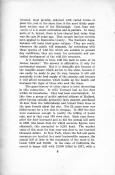 |
| 7 |
0008 |
value conservatively estimated at
one-quarter of a million dollars. There is an angle pertaining to
other values which is of deep interest. Maine, for example, which we
mentioned previously as having no game in 1877, has so well husbanded
her wild life resources since, that today she estimates that nearly
$2,000,000 are left within her borders each year in return for licenses,
for supplies, for guides, for hotels, and all the other things for which
a tourist or a hunter or an angler will spend his money, when he gets
away from home. Similarly California, wide-awake and always on the
lookout for the entertainment of the pleasure-seeker, has him leave with
her each year between $15,000,000 and $20,000,000. Other states can tell
similar though less opulent tales. The point to keep in mind is this:
that neither California or Maine is inherently better off, so far as
natural conditions favoring wild life are concerned, than is North
Carolina, or Virginia. The chief difference is that the states which now
have plenty of certain kinds of game are giving it the protection it
must have. They have put themselves to a good deal of trouble and
expense to bring the wild life back, while some of our Southern
Appalachian states have not troubled themselves about the matter, but
have let the game-hog and the fish-hog clean up as they go. They should
call to mind the aphorism that "nothing is had for nothing." Good
hunting and good trout fishing in a region such as ours would mean the
immediate advent of thousands of sportsmen. There are counties in the
Southern Appalachians and in North Carolina which might readly be made
self-supporting—as in northern Pennsylvania— by properly caring for fish
and game resources.
As we consider the fisheries of the region the outstanding fact is
that in a way in the Southern Appalachians the record parallels that of
game. Well stocked streams filled with fish were the usual thing even to
a comparatively late date. This condition does not obtain today. While
there are a few streams well stocked it is
|
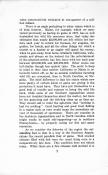 |
| 8 |
0009 |
the exception rather than the rule. Clearing, lumbering, dynamiting,
pollution Iron mines and factories, and unchecked fishing have all
contributed to deplete some of the finest of mountain streams, the
natural habitat of the trout. But if there is one thing to be
learned from past experiences in fish culture, it is this: that where
the planting of fry and fingerling is carefully done, and where the
streams are given protection thereafter, the successful rehabilitation
of the life therein can be accomplished with perfect ease. None of the
Southern Appalachian states is doing all that could be done to help in
this work. Countries abroad have had the foresight for years to adopt
every feasible means of maintaining and increasing their fish supply.
The food supplies from the streams and coastal waters were turned to
good account by them in the World War. Even in this country we learned
to eat fish which had previously been assumed to be unpalatable. The
Federal and State Governments began to take cognizance of fish culture
about 1870. The results of artificial restocking have amply justified
the optimism of the scientists and the sportsmen who first broached the
plan. Working plans have been outlined in some states designed to
determine the character of all waters within the state, to find out more
about the natural food supply of the fish, to study the enemies of spawn
and young fish, so that it may be set down in black and white how to
manage each stream to best advantage. But in a majority of the states
the streams have not been properly protected, and even less is known of
the habits, the food, and the reproductive capacity of the fish than of
the game. We do not have adequate legislative safe-guards thrown around
our streams. Too much unnecessary pollution is allowed to be dumped into
them. Commercial interests too are selfish in their attitude and are
inclined to resent any sort of control over their action. But, as with
game, the true conservationist does not ask for the impracticable or the
impossible. Dams across rivers may interfere with the spawning of
certain species of ascend-
|
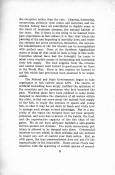 |
| 9 |
0010 |
ing fishes, but no one would think of
wholly obstructing water-power development on that account. In such
cases progressive states compel the construction of fish ladders by
which means the fish can continue their way over the dams and up the
stream. The waste waters of certain-industrial plants must be returned
to the streams, but it is often possible to accomplish this in better
ways than is now done. There are practices which ought to be forbidden
by law: sawdust from the mills and slime from the mines should never be
permitted to get into the streams. Both have a most deleterious effect
upon the fish life. In this state there is no general law of this
nature, but some of the counties have protection and some do not. Our
own county of Buncombe once had a "no-sawdust" law but someone had it
repealed and today any portable mill man may turn all of his sawdust
into the streams, kill all of the fish for miles and destroy the
portability of their waters. We can have laws which will deter people
from fishing during the spawning seasons; we can have hatcheries over
the state, rearing species most suited to home waters; we can study the
character of the food supply as affected by changed conditions due to
lumbering, to clearing of lands, to forest fires; we can plant fry and
fingerling and bring back the population of the streams to their former
virgin condition. Let me quote in this connection from the last issue of
the bulletin from the Fish and Game Commission of the State of
California: "If there were no other justifications for the existence
of the Fish and Game Commission, it could well rely upon the results of
its attempts to stock the streams of the state. Hundreds of lakes and
streams formerly barren of fish life now contain millions of fish
and these fish furnish food and recreation for all who will cast a fly
or drop a line. Trout are now to be found in nearly every living stream
easily accessible to the angler. Furthermore there have been introduced
into the waters of the state a number of food and game fishes not
formerly found here: Bass and shad and other species now add greatly to
our fishery resources. Due to the activity of the Commission the state
of California offers fine fishing
|
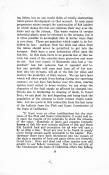 |
| 10 |
0011 |
as can be found anywhere, for
there are more fish in the lakes and streams today than there were when
the first white man came to the state. Reports from all over the
state show that notwithstanding the heavy drain on the lakes and streams
by an ever increasing number of anglers, the number of fish, trout
particularly, have grown, where proper conditions prevailed. Automobile
travel has increased the desire of the people for fishing. More persons
fish and more fish are caught than ever. Some day the limit will be
reached and legislation will be needed to restrict the number of days of
fishing, or limit the number of fish taken, or limit the duration of the
open season." What are the best methods of obtaining the increase of
fish and game we desire? In the first place, we need good laws, certain
restrictions placed upon the killing, hunting, and disposition of game.
It is often observed that we now have too many laws and, furthermore,
that there is no need of laws unless they are enforced. Both
observations are partly correct especially with respect to this state,
as we shall see later. Nevertheless we must have some good laws in order
to assist wild life in its unequal struggle for existence. There are
many law-abiding men who will hunt and fish where the laws are lax.
In the second place, methods of obtaining more fish and game must be
put into effect. This may be accomplished by the establishment of public
and private preserves and the erection of hatcheries for the propagation
of fish.
And then we need publicity. We need to present the facts with
accuracy and with simplicity. California's slogan has been for many
years "conservation through education." It is both a sensible and a
practical point of view. The public has to decide in the end whether or
not wild life shall stay, and the public can be won for the cause if it
has the record truthfully and insistently presented.
How, you may ask, are these things to be done unless considerable
funds are at hand ? They cannot be done without money, but there is one
practical way of obtaining it. So far as my information goes it has not
been a failure in any state where fairly tried and willingly sup-
|
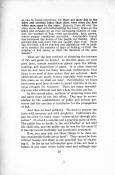 |
| 11 |
0012 |
ported by the public. It is by
incorporating into a statewide law a charge tor fishing and hunting
licenses. This places the burden on those who seek recreation of this
character and in general this is just and is not objected to after it
has been in effect for a time. It fails to be entirely just in making
the license fee the same for the sportsman who fishes for pleasure and
the interests who fish solely for profit. The basis for the two fees
should not be the same. A brief record of a few of the states which have
a general game law with the license feature throws a burning light on
the results made possible thru its actual operation. Tennessee which
has a comparatively new game law had in 1916 receipts amounting to
$34,000. Disbursements were $15,000.
Year Receipts Disbursements
Kentucky________1915-16 $34,000.00 $12,000.00
_______1916-17 63,000.00 35,000.00
_______1917-18 70,000.00 46,000.00
Virginia_________1916-17 $88,000.00 $67,000.00
Maine_________1895-1918 25,000.00 100,000.00
(No comments on disburesments available)
Massachusetts______1917 54,000.00
Small reserve left.
New York_________1917 365,000.00 320,000.00
California_______1914-15 319,000.00 272,000,00
_______1915-16 320,000.00 320,000.00
Many other states could be listed, but these are enough to support
the argument that the license system can readily furnish funds enough if
properly applied. The disbursements given above cover not only the
expenses of the Fish and Game Commission, but go for wardens and deputy
wardens' salaries, for hatcheries, for experiments in restocking with
exotic species, and all sorts of legitimate ends which the various
Commissions with to accomplish.
In any scheme for increasing the wild life resources in the Southern
Appalachians the fact that the Federal
|
 |
| 12 |
0013 |
Government is a property owner in this region must be taken into
account. Up to date the Government has purchased in round numbers about
1,000,000 acres of the mountain lands, south of Pennsylvania. This is
about equally distributed through the states of Virginia, North
Carolina, Tennessee and Georgia. There is none as yet in Kentucky, and
the portions in West Virginia and South Carolina are not large. Each one
of these purchased areas should be made a game preserve either by
Congress or by the states themselves. As I view the question, it does
not much matter which one has control of the game, the Federal
Government or the State, so long as the results desired can be obtained.
If the state Governments feel their responsibility in the matter of
protecting wild life, then there is good reason for them to wish to keep
these resources in their own hands. If not, then the Federal Gov-.
ernment should act. These areas do not have much wild life within their
boundaries now but they are capable of sustaining, in addition to the
domestic stock which they can carry, between 30,000 and 50,000 head of
deer from which an annual kill of not less than 10,000 could well be
made. Every state which has not already done so should enact a state
wide game law, putting the administration of the law up to a Fish and
Game Commission created by it, and giving it liberal powers-of action.
In North Carolina the present game laws are so intricate and so local
that they are often violated in ignorance. As they now stand on the
statutes there is no living person who can give a summary of their
purport. We have the county system which is very bad. Enforcement of the
game laws by the counties is farcical. Think of a state having 36
different open seasons for deer! In nine counties in the eastern part of
the state where natural conditions are quite similar, there are fourteen
different open seasons for deer, due to different county laws, and even
to different laws in the various townships in the counties. For
partridge or grouse we have 40 different periods of killing. Then the
bag limits are, too, variable. Our neigh-
|
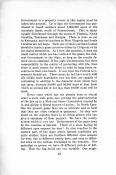 |
| 13 |
0014 |
ported by the public. It is by
incorporating into a statewide law a charge tor fishing and hunting
licenses. This places the burden on those who seek recreation of this
character and in general this is just and is not objected to after it
has been in effect for a time. It fails to be entirely just in making
the license fee the same for the sportsman who fishes for pleasure and
the interests who fish solely for profit. The basis for the two fees
should not be the same. A brief record of a few of the states which have
a general game law with the license feature throws a burning light on
the results made possible thru its actual operation. Tennessee which
has a comparatively new game law had in 1916 receipts amounting to
$34,000. Disbursements were $15,000.
Year Receipts Disbursements
Kentucky________1915-16 $34,000.00 $12,000.00
_______1916-17 63,000.00 35,000.00
_______1917-18 70,000.00 46,000.00
Virginia_________1916-17 $88,000.00 $67,000.00
Maine_________1895-1918 25,000.00 100,000.00
(No comments on disburesments available)
Massachusetts______1917 54,000.00
Small reserve left.
New York_________1917 365,000.00 320,000.00
California_______1914-15 319,000.00 272,000,00
_______1915-16 320,000.00 320,000.00
Many other states could be listed, but these are enough to support
the argument that the license system can readily furnish funds enough if
properly applied. The disbursements given above cover not only the
expenses of the Fish and Game Commission, but go for wardens and deputy
wardens' salaries, for hatcheries, for experiments in restocking with
exotic species, and all sorts of legitimate ends which the various
Commissions with to accomplish.
In any scheme for increasing the wild life resources in the Southern
Appalachians the fact that the Federal
|
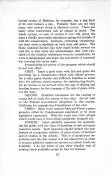 |
| 14 |
0015 |
FIFTH: Organize an association of
sportsmen whose aid in getting proper legislation enacted would be
invaluable. SIXTH: Stock the forests and the waters with good native
stock, where possible.
If some such plan is carried out in the Southern Appalachians our
wild life will be safe from extermination, our food supply will be
augmented, our assets added to, our waste lands alive with animals and
birds as in olden days, our streams full of the leaping trout, and our
mountains thronged with those whom the "Red Gods" call.
|
 |
| |
|
|
|

















